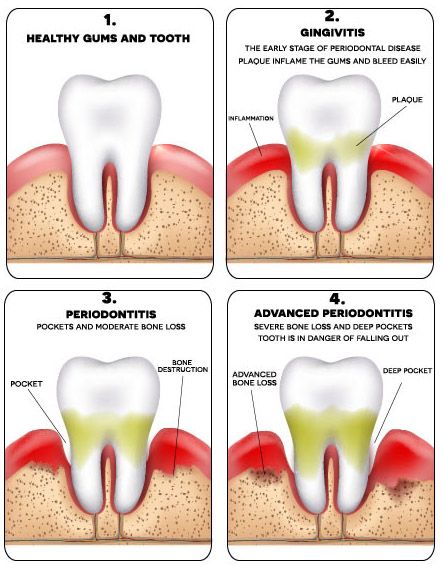What is parodontopathy or paradentosis, What are the causes of parodontopathy, Development stages, Symptoms and the treatment of paradentosis…
What is paradontopathy (paradentosis)?
Parodontopathy (paradentosis) is a periodontal disease, or a tooth support device. The disease has several stages, depending on the severity of the consequences. If it is in its advanced stage, parodontopathy can lead to tooth loss. The drastic outcome can be due to the fact that periodontal disease results in a gradual destruction of periodontal tissue, which eventually results in receding and loss of a jawbone and a tooth has no adequate support, it gets loose and falls out eventually.
It is very important to emphasize that periodontal disease cannot be cured completely. This means that gums (and the entire supporting dental apparatus) cannot be recovered and returned to their initial state, a healthy condition, once having been damaged by paradentosis. It is therefore crucial to notice the first symptoms of paradentosis in order to stop the disease at an earlier stage. The initial stages are not dangerous, and the treatment at that time is extremely simple.
What are the causes of periodontal disease?
The occurrence of periodontitis is primarily due to dental plaque and tartar. Dental plaque is a colourless, sticky mass that accumulates on teeth mainly as a result of food particles. The dental plaque consists of bacteria that produce endotoxins (harmful substances) that trigger immune system on defence. With this interaction, there is inflammation, further bone resorption (loss), the occurrence of periodontal pockets, and a complete destruction of periodontal tissue and tooth loss. Therefore, dental plaque is harmful to gums.

Tartar is formed when dental plaque is blended with salts and minerals from saliva. Tartar affects gums negatively by creating places where the plaque additionally accumulates, and it is more difficult to remove. In addition, tartar can also exert mechanical pressure on gingiva, which also affects the occurrence of periodontal disease.
In addition to plaque and tartar, there are other factors that can lead to periodontal disease:
- improper and irregular oral hygiene
- smoking
- bad prosthetic work
- systemic diseases
- anomalies of the shape and position of teeth
- genetics
- the use of some medications
Stages of development, symptoms and treatment of paradentosis (paradontopathy)
The first stage in the development of paradentosis presents gum inflammation (gingivitis). Gum disease is the symptom of paradentosis. If not noticed and treated in time, gum inflammation usually becomes paradentosis. The symptoms of the disease can worsen, such as soft and red gums. Since these symptoms are not easily detected, then the most common symptoms are painful and bleeding gums. If your gums bleed during brushing your teeth (or a similar mechanical pressure on gums), then this is a sign that you should contact a dentist. The therapy involves the removal of dental plaque and tartar along with the instructions on the proper maintenance of oral hygiene.
The second stage is characterized by similar symptoms as in gum inflammation. However, what indicates that gingivitis has grown into parodontopathy is a more frequent occurrence of the following symptoms: periodontal pockets and the appearance of some new feeling like burning of gums. Still, it can still be considered that the disease is in its initial stage, so the treatment of paradentosis can be done in a simple and easy way by removing the plaque and tartar, as well as in the case of gingivitis and pockets. With an increased oral hygiene, a patient can completely stop the development of periodontal disease.
At the third stage, there is gum recession. It is clearly visible, because gums are retreating, leaving a root tooth bare. In this way, the tooth itself is exposed to additional danger from getting infected, since a root tooth is “more vulnerable” than a crown. Along with gum recession, teeth also lose support, and they become loose. This stage means that paradentosis has already advanced, and the treatment is quite difficult. The therapy implies surgical intervention with a small incision on the gums to lift them. Afterwards, by using certain medications (PRF and Endogain) bone regeneration is stimulated. In this way, the support of a tooth is returned and it can be preserved.
The fourth stage is the ultimate stage when a jaw bone recedes quite noticeably, and a tooth falls out. Then the treatment of paradentosis is completely disabled. The only thing that can be done is the prosthetic care of a patient.
Although parodontopathy (paradentosis) is a disease that cannot be cured, it can still be stopped if the symptoms are noticed in time. Remember that healthy gums do not bleed.
The dental office Dental Vortex performs therapies for all stages of the disease. Therefore, feel free to call us and schedule a check-up.

